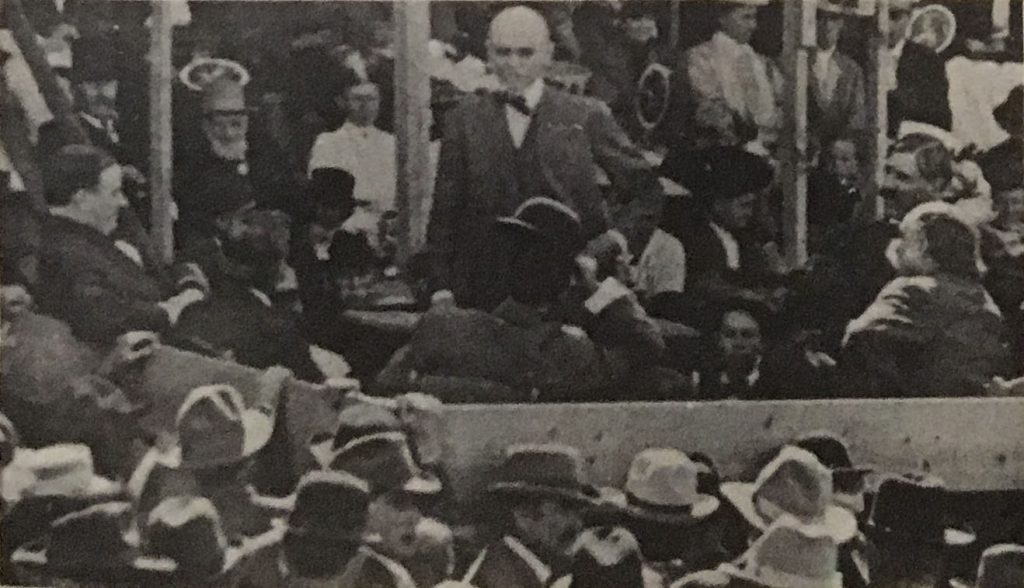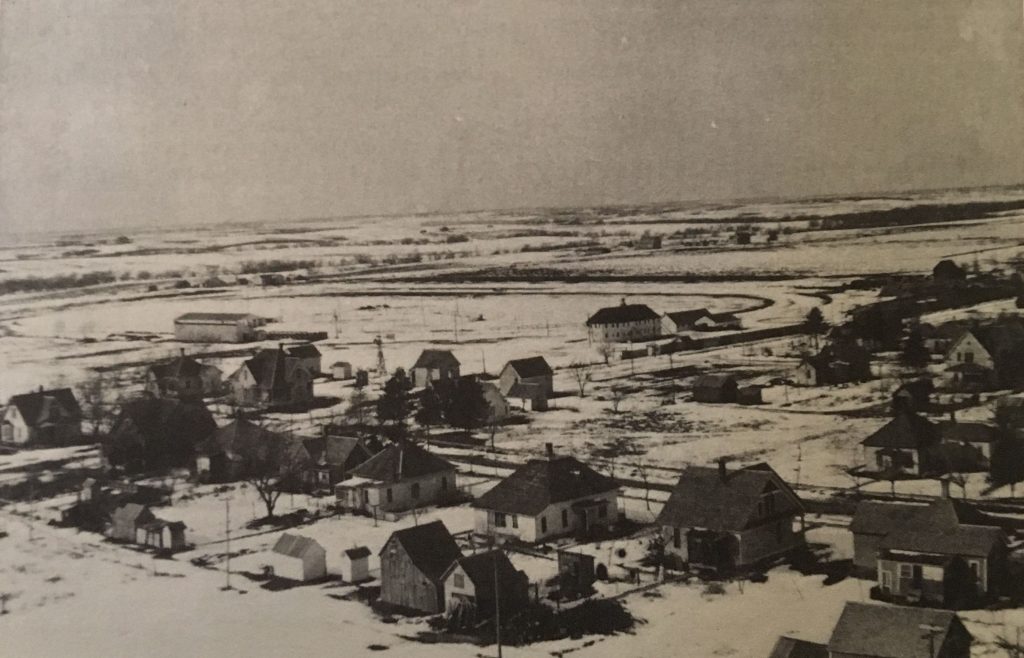All of the following comes from the 1986 Bladen Centennial Book titled “Bladen: The First 100 Years” pages 42-46.
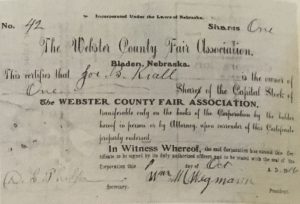
Each of the 57 original shareholders received a stock certificate like the one above which was issued to Joseph B. Kral on October 1, 1906.
Before the County Fair was organized, a fall festival or Soldier’s Reunion was held at the site of the current fair grounds. There was always a small carnival consisting mostly of rides, a speaker who talked mainly on the current issues, and also a ball game between Bladen and a neighboring town. It was mostly a “get together” for old friends and neighbors.
John Baker, a Bladen resident who owned one of the few cars in the community, would give rides to anyone wanting to go from downtown Bladen to the fairgrounds and back. The trip cost 25 cents.
Each town in the county had its own location for similar celebrations. When interest grew in a county wide agricultural fair in the early 1900’s all the towns vied to host the event. The final struggle was between Bladen and Red Cloud, the county seat.
Bladen won. Some say the reason was that Red Cloud’s train depot was too far from their downtown for people to walk easily to the fair. Others say that a contingent of the “pious” in Red Cloud did not want to bring horse racing and its attendant evils – gambling, liquor, and wicked women – to their town.
Bladenites were eager for the boom a county fair would bring to their summertime economy. Fifty-seven shareholders formed the Webster County Fair Association and purchased land from Charles Spence for new facilities. It was a busy first year as they put up a grandstand, organized baseball games, spent $500 for horse races, $100 to put down a well, $50 for baseball uniforms, and awarded nearly $500 in premiums on exhibits. Officers in charge for that first Webster County Fair in 1906 were Bill Wegmann, president; Joe Denton, vice president; A.E. Cox, secretary; and A.R. Rudd, treasurer. Board managers were Sam Hogate and C.H. Hasebrook.
Association meetings over the years have been held in the G.A.R. Hall, the Oddfellows Opera House, Iverson’s garage, Denton’s store, the State Bank, Cox’s store, and the Service State Bank. Some of the early secretaries were D.S. Phelps, O.L. Lindgren, F.E. Crawford, Charles Cowley, Leroy Spence, Seth Greene, and S.P. Duncan.
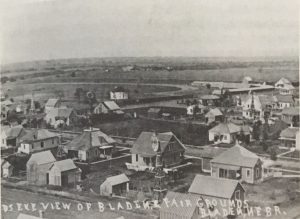
Early day view of Bladen Fairgrounds when Bladen still had its windmills.
Early Days
Band music was a part of the early day fairs with bands from the surrounding towns paid to provide the music. There were days dedicated to special groups like Woodmen of the World. In 1908, Wednesday was the day for those who spoke for Taft; Thursday was Bryan Day. Groups were given free use of the ampitheater for their speeches at 10:00 a.m. William Jennings Bryan himself spoke at the 1912 fair.
Also in 1912, according to the Enterprise, C.R. Rakestraw erected a large “eating tent” on his lot east of his Bladen Cafe to handle the hungry crowd expected at the county fair. A Booster Trip was organized with 50 automobiles In the caravan which visited all the county towns and other surrounding villages. Thornwell Andrews, the famous aviator, and his Curtiss biplane was one of the big fair attractions, as was the Lewis Stock Company. The Burlington was running a special train into Bladen every morning of the fair, bringing folks into Bladen from Guide Rock, Red Cloud, Cowles, and other towns, and returning them home in the evening.
Mornings at the fair brought shooting matches with the Bladen Gun Club’s Bill Wegmann in charge. G.P. Cather, an active member, no doubt came in for his share of the prizes. Afternoons saw baseball games on the fairgrounds diamond. One year home talent plays from neighboring towns were staged each evening in front of the grandstand.
Horse races were the big event, but there were also chariot races with mule teams instead of horses, running races in flour sacks, men against horses, Model T races in reverse, pig races, anything different that fertile imaginations could devise.
As soon as city lights and water were available, installation was made at the fairgrounds. First wiring for lights cost $43.60. Soon after electricity was added, the Fair Association gave permission to Cub McCoy and E.E. Saylor to run a dance every week and each night of the fair. The fair board insisted that lights be placed on the outside of the building, that the place be policed, and that McCoy and Saylor bear all expense.
Harold Spence describes the Webster County Fair of his childhood. “Sights? Begoggled sulky drivers leaning inward as they rounded home-stretch of the half-mile track; spurring their horses on with shouts and snapping whips…the afternoon sun glinting on the horns of bandsmen in the stand across the track…the bright parasols of the women, their ankle-length dresses and muttonleg sleeves.
“There were sounds to remember too. The thudding of hooves on the track, the insistent clang-clang-clang of the iron triangle from the lofty perch of race judges as drivers were called back for a new start. The hurdy-gurdy tunes of the merry-go-round, the clanking of the ferris wheel gears, the cry of barkers along the midway and the clickety-click of the Wheels of Fortune.
“Away from the pleasure-bent throng there were sounds of another sort…the stamping of the big Percherons in their stalls, a plaintive baa-a-a-a from the sheep pens, the snuffling and grunting from swine enclosures and the crowing and cackling and cluckIng cacophony from the poultry cages.
“The smells were varied, too. The aroma of field grasses and sacked grains, the heady bouquet of fruits and vegetables in the exhibit halls, the mouthwatering savor of frying hamburgers along the midway and the cigar smoke hanging heavy in the grandstand. There was that horsey smell surrounding the race barns and the barnyard odors from the livestock pens, tempered with the fragrance of bright new straw used in bedding down the animals.”
Horse Racing
As the founding fathers had foreseen, harness racing drew major crowds to the Webster County Fairgrounds. The half-mile track earned a reputation as the fastest in the state. Even today, 30 years since the last hooves and sulkies pounded over it the track’s oval outline appears on aerial view’s of Bladen.
Ruth Richendifer recalls those August days as busy ones in Bladen. Her husband Louie always found all three barber chairs full with more customers waiting during fair time. Everyone tried to get the day’s work finished in the morning. Afternoons were for the races. After lunch, everyone dressed in his finest and joined the crowds at the grandstand. Women in long skirts, carrying parasols against the sun, men in suits and hats, all gathered to see and be seen. From the circular bandstand came the strains of Sousa marches played by the Plainview or Bladen band. Post time was 1:15, and the races continued until late afternoon. Betting was not organized, but people laid private wagers on their favorite horses and trainers.
Many local livestock breeders entered trotters at the Bladen races. For some, it was more than a hobby. John Anderson was the first in the area to raise and train race horses. One day he took the train to Lincoln and drove home a team of Kentucky bred racers purchased from C.E. Hicks, a one-time Bladen druggist. From this pair came a long line of colts like Mamie Mac, winning harness racers not only at Bladen but all over the country.
Anderson hired Bert Collicott as his trainer. A sometime mason who helped to build the State Capitol in Lincoln, Collicott’s true love was horses. The Anderson bloodlines were good, and Collicott was usually first across the finish line.
In partnership with horse fancier H.E. McCoy of McCoy’s Meat Market, Collicott bought an Anderson colt. They entered him in races as far away as South Dakota and Alabama against some of the fastest horses in the country. Between 1924 and 1926, he won 17 races in 20 starts. This horse, Prince Mac, was sold to an Omaha millionaire for the record price of $2500.
A Hastings Tribune account at the time stated. “The Anderson brothers can well feel proud of the records made by these eight sons and daughters of Josie who have gone out to different sections of the country…Bladen horsemen and Nebraska people in general were proud of Prince Mac…They will watch with interest his future success as he is a home product.”
After sulky racing was discontinued as part of the fair Bert Collicott and Charles Relchsteln trained trotters and pacers at the Bladen facilities. There were usually 12-15 horses in the barns. School children of the late 50’s remember loitering at the track after class to watch the proceedings.
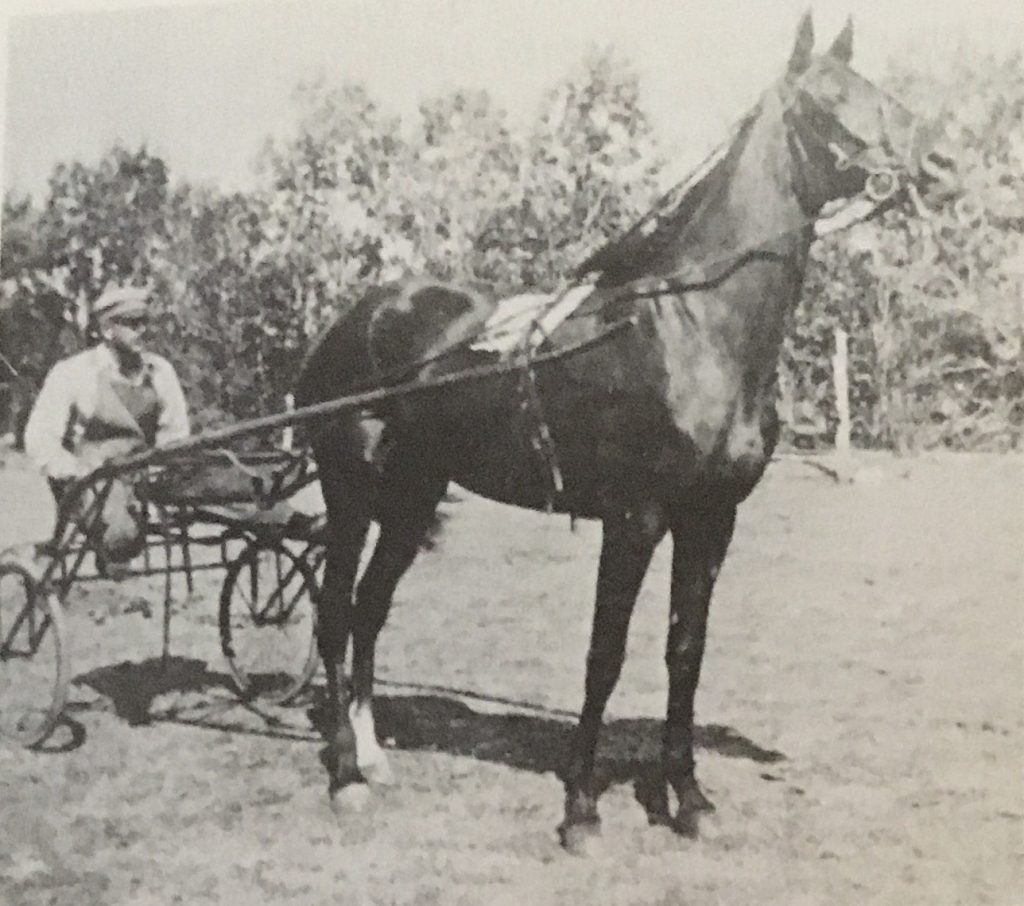
Bert Collicott, trainer, with John Anderson’s race horse, Mamie Mac, four years old, 1917. 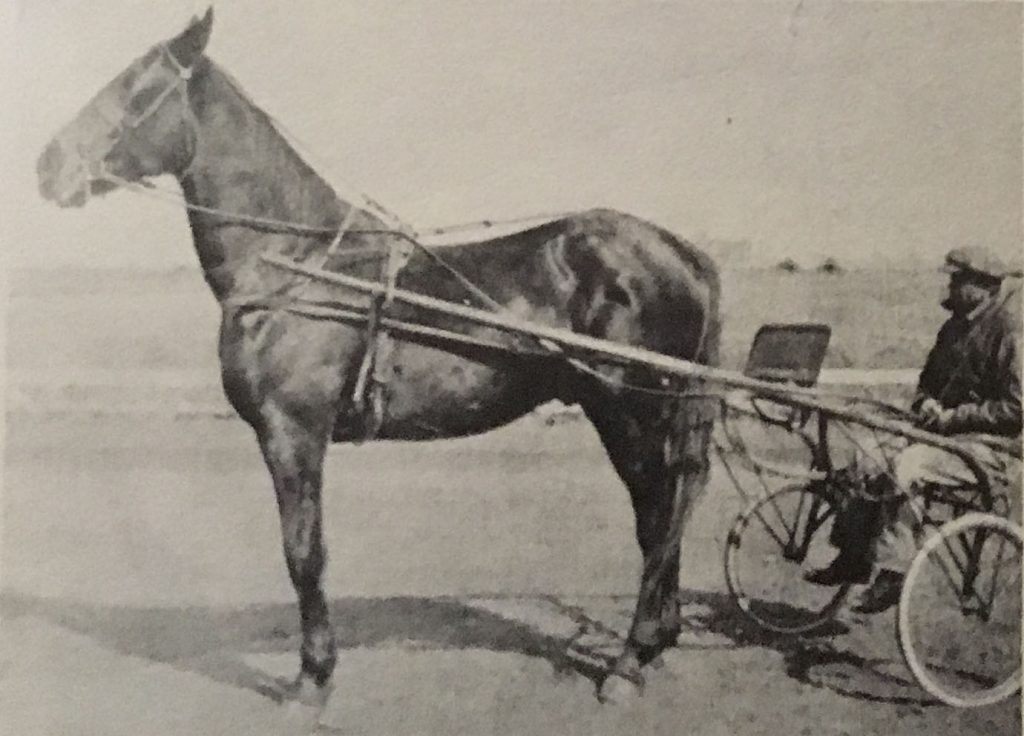
Prince Mac, one of the Anderson horses, owned by Herb McCoy and Bert Collicott who is holding the lines. 
Finish of a race at the Webster County Fair, with Bert Collicott in first place. To park across the track in a special place required an extra ticket.
Rodeos
Horseracing at the Fair ended in the late 20’s. Looking for a new crowd pleaser, the Fair Association got up the first rodeo in 1933 using local stock from the old Thorne ranch. In 1935, they dealt with a professional stock contractor from Dorchester.
Beginning in 1948, with a new $8000 grandstand ready to seat a thousand spectators, Bladen hosted an R.C.A. Rodeo put on by Paul Long and attracting some of the biggest names in the business. Tom Stoughton recalls the year Jim Shoulders flew down from Burwell to rope and ride in the evening competition. He became a national champion “All Around cowboy,” as did Paul Tierney, a Chadron State College team member who competed In Bladen In the early 70’s. Clown Buddy Heaton with his trained buffalo appeared in the Bladen arena in 1961, coming off a triumph at Madison Square Gardens.
The R.C.A. Rodeos gave way to the Nebraska Rodeo Association events which in 1986 are still going strong – three nights of riding, roping, steer wrestling, and barrel racing. Among the locals who have competed are Colleen Borwege and Leonard Kucera, Mitch Soucek, Dave Baker, Kelly Skrdlant, Jim Kaufman, and the infamous team of Mike Kral/Dennis Erickson/Pat Danehey who put an end to the wild horse races by drawing stockman Max Hebb’s worst outlaw and breaking him to ride.
Facilities have come and gone. The grandstand was blown down by a tornado in the late 50’s. The “chickenhouse” that served Bladen as a school in 1924 is long gone. Old livestock barns have been replaced with new. During the 70’s a new 4-H Exhibit Hall and a covered show arena were constructed with the help of Ak-Sar-Ben funds. The 4-H and Methodist food stands are now permanent installations. When the meals were served from a tent in 1954, the menu advertised “Fried Chicken Dinner with All the Trimmings (including pie and coffee) – 85¢, Hamburgers – 15¢, Hot Dogs – 10¢, Pop – 10¢. Breakfast: Three Pancakes and Coffee – 25¢.”
Competition is keen in both 4-H and Open Class exhibiting. Hogs and cattle have been the 4-H classes with the most entries over the years. The quality of Webster County beef cattle is something judges brag about at other fairs across the state. In the past 10 years, sheep numbers have been gaining. Horse shows have always drawn special attention, with Borweges and Vances bringing home many purple ribbons from the State Fair over the years.
Everything has happened at the Bladen Fair, from marriage to murder. August 27, 1937 saw a horseback wedding in the rodeo arena. Fay Hudson, a trick rider from Diller, and Vic Blackstone, a Texas cowboy, were married by Bladen’s Justice of the Peace, C.R. Rakestraw. Although Mr. Rakestraw was not accustomed to a horse’s back and was rather shaky about the entire affair, the hitch was made to the cheers of the spectators in the grandstand.
That same lair brought further excitement when James Roby of Little Rock, Arkansas, was found dead in an automobile south of town. He had three bullet holes in him. His wife Flossie May reported that they had had a scuffle and she was afraid he was shot. She and her boyfriend, members of the carnival, were suspected. Arrested but pleading not guilty, she was held in the Webster County jail until November. She was discharged because no motive could be found and, according to County Attorney George Reinmiller, “to proceed to trial would only be needless expense to the county.”
The story of the incident appears In Webster County District Court records as follows:
“That the defendant (Flossie May Roby) and her deceased husband were in a group of carnival people that were drinking and quarreling. That the deceased was a robust man of 220 pounds and the defendant, his wife, a woman weighing about 100 pounds whom he had been exploiting her by using her as a hula dancer in his show, contrary to her wishes. That on the street in Bladen deceased struck defendant several times and then drove her just south of town in his car where defendant says the deceased tried to shoot the defendant with a revolver which the deceased carried in his car, but that she managed to keep him from doing so by wrestling the gun from him, and shot him in self defense. That there was no one present except the defendant and her husband, now deceased, at the time of the shooting, and that she immediately summoned a doctor and the Constable of Bladen.”

Bladen’s first hosting of the Webster County Fair in 1906. Livestock exhibits line up in front of the grandstand with the prize-winning bull at the left of the row. 
Baseball game in progress at the Webster County Fair, the Plainview team in dark uniforms, Herb McCoy is the umpire behind the pitcher. The old schoolhouse shows in the background. The horse barns are behind the cars, parked so spectators can watch the ball game.
Eighty years of festivities have left memories of fairtime highjinks: Barney Buss and Bill Vaughan flying in the Sunday papers and dropping them on Bladen from the air, brawls and footraces between the cowboys and the “aggies,” horse pulls, tractor pulls, demolition derbies and mud runs, wiffle ball and broken legs, constructing parade floats (133 rolls of toilet paper), the band on the ferris wheel, local favorites as dunking booth targets, rodeo clown performances by Jerry Kaufman, Charlie Lovejoy and Phil Boyd three wheeler leaps through burning fire and hidden water geysers, tending the barbecue fire all night, escaping rodeo stock longeared calves born to local herds the next spring, political campaigners shaking hands, square dances, rock dances, disco dances, the lights and noise of the Midway, after the fair clean-up, water fights, and hayrides…
